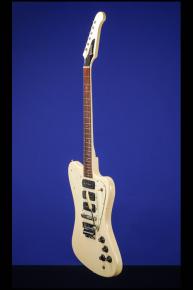A Custom Color Firebird III.
1967 Gibson Firebird III "non-reverse"
This 'custom color' "non-reverse" Firebird weighs 8.20 lbs. and has a nut width of just over 1 9/16 inches and a standard Gibson scale length of 24 3/4 inches. Solid mahogany body, one-piece mahogany neck, and unbound rosewood fretboard with 22 jumbo frets and inlaid pearloid dot position markers. Headstock with gold-painted "Gibson" logo on black plastic truss-rod cover. Serial number "003605" stamped on the back of the headstock. Kluson open-back six-in-a-line strip tuners with oval metal buttons. Three black soapbar P-90 pickups with outputs of 8.29k, 8.25k and 8.95k. Three-layer white over black plastic pickguard with ten screws and "Firebird" emblem painted on in red on the upper bass side. Four controls (two volume, two tone) on the lower treble bout, plus three-way pickup selector switch on the upper treble side of pickguard. Black plastic ribbed-side conical-shape "Witch Hat" control knobs. Intonation adjustable stud bar bridge/tailpiece with pre-set ridges and factory Gibson short Vibrola tailpiece with walrus tooth tip. The potentiometers are stamped "137 6626" (CTS June 1966). There is some fine finish checking and a few small and surface chips on the edges of the body, the back of the neck and the edges of the headstock. There are two small cracks on the pickguard (by two of the screws) and the red 'Firebird' emblem is almost rubbed away. Overall this custom color Firebird lll is in excellent plus (8.75) condition. Housed in the original Gibson three-latch, rectangular black hardshell case with orange plush lining (8.75).
"Announced in Spring 1963, the original Firebird series was conceived as an attempt to produce less conventional electrics likely to appeal to Fender players. Four different models, identified by odd Roman numerals, were marketed simultaneously...The four models produced between 1963 and 1965 (a.k.a. the 'reverse' Firebirds) share the same body specifications and differ only in fretboard style, electronics and hardware...The original Firebird electrics are primarily characterized by: a neck-through-body construction; a reverse body shape with extended lower horn; a reverse peghead with the treble E tuner nearest to the nut; banjo-style tuners with rearwards buttons; and they are all equipped with mini-humbuckers built without adjustable polepieces. The early samples are characterized by a 2-piece full length neck and a convex heel where the neck blends into the body. By late 1963, production models were released with a stronger 9-piece lamination and a smaller squared-off heel. A painted-on red Firebird emblem was also added on the white pickguard... For all practical purposes, the Firebird lll was the equivalent of the Special found in the SG/Les Paul family. Compared to the FB l, the model is characterized by: a bound rosewood fretboard -- two pickups -- individual volume and tone controls for each pickup -- a 3-way toggle switch for pickup selection -- a (short) Vibrola tailpiece with flat metal lever. In spite of a Vibrola tailpiece, the FB lll sports the same bar bridge with a pre-set ridge as the FB l. And because of its stud-anchoring this bridge cannot be replaced by a fully adjustable Tune-O-Matic bridge… CMI and Gibson took the decision to discontinue the original Firebirds in early 1965 and by June a new breed of models (a.k.a. the 'non-reverse' Firebirds) was announced" (A.R. Duchossoir, Gibson Electrics -- The Classic Years, pp. 198-199).
The 'new' non-reverse Firebird lll featured not just two P-90 pickups but a luxurious three!!!!!
"The Firebirds flew. They didn't soar, but they were no turkeys. Then Gibson 'fixed' them. The first fix was understandable: putting the tuners on the bass side of the headstock for easier access. But then Fender complained that the Firebird infringed on its patented offset-waist body design, so the body was changed to a non-reversed shape and made shorter and fatter-looking. The neck-through was replaced by a glued-in neck. And on the lower two models, single-coil soapbar pickups were substituted for the Firebird-style humbuckers: The only thing that was really fixed was the Firebirds' goose. They were gone by 1969" (Walter Carter, Gibson Guitars: 100 Years of an American Icon, p. 237).












